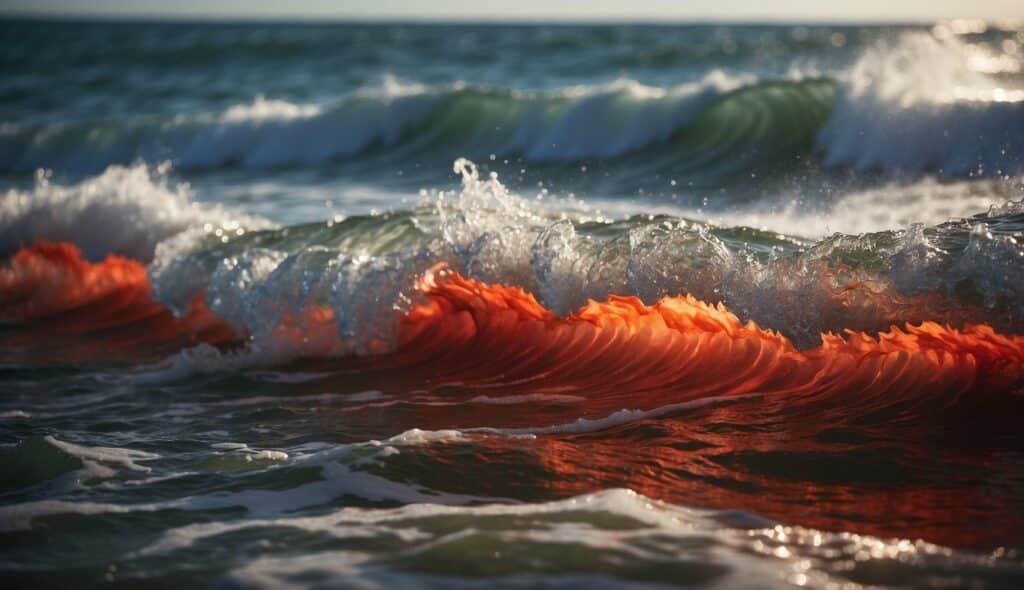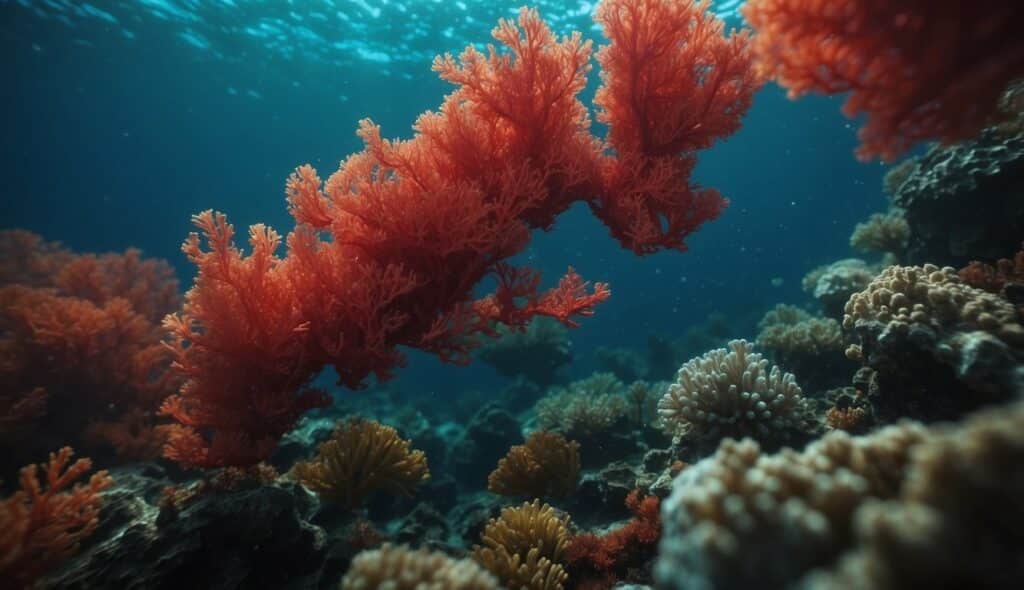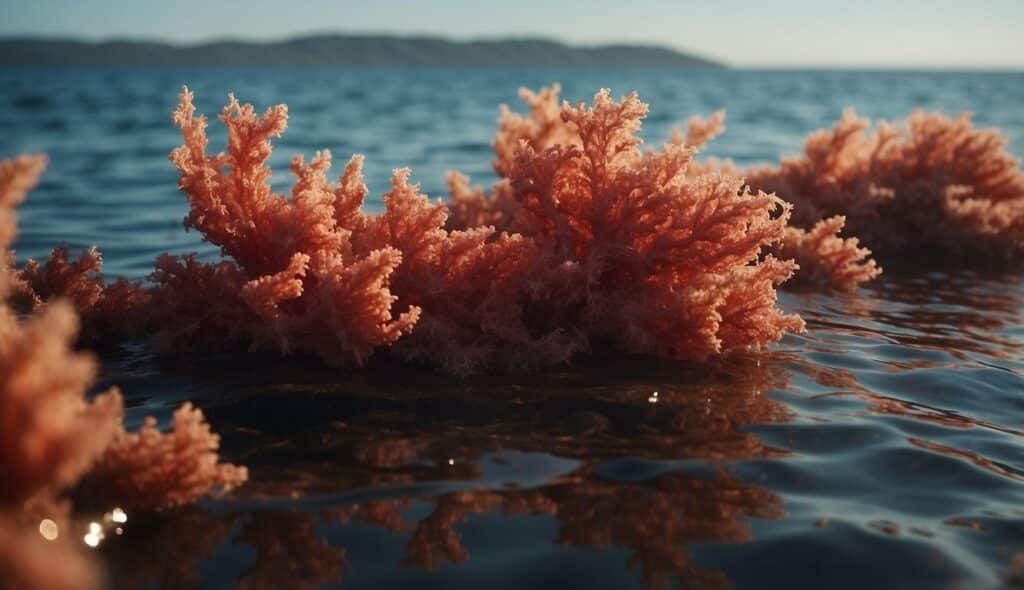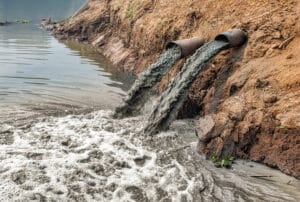If you’ve ever been to a beach and witnessed an unusual red tint to the water, chances are you’ve seen a red tide. Red tides are a natural phenomenon that occur when certain species of algae grow out of control, resulting in a discoloration of the water. While red tides can be a beautiful sight to see, they can also have negative impacts on marine ecosystems, human health, and local economies.

Understanding red tides is crucial in order to effectively monitor and prevent their occurrence. Scientists have been studying red tides for decades, and while much is still unknown about these events, we do know that they are influenced by a variety of environmental factors and can be exacerbated by climate change. By monitoring and forecasting red tide events, we can work towards implementing prevention and control measures to mitigate their negative effects.
Key Takeaways
- Red tides are caused by an overgrowth of certain species of algae in the water.
- Red tides can have negative impacts on marine ecosystems, human health, and local economies.
- Monitoring and forecasting red tide events is crucial in order to implement prevention and control measures.
Understanding Red Tides
Definition and Characteristics
Red tides, also known as harmful algal blooms (HABs), are a natural phenomenon that occurs when there is an overgrowth of certain types of algae in the ocean. These algae, specifically dinoflagellates, can produce toxins that are harmful to marine life and humans. The name “red tide” comes from the discoloration of the water caused by the high concentration of these algae.
Red tides can vary in color, from red to brown to green, depending on the type of algae present. They can also vary in intensity and duration, with some lasting only a few weeks while others can persist for months.
Causes of Red Tides
Red tides can be caused by a variety of factors, including nutrient pollution, changes in water temperature, and changes in ocean currents. Nutrient pollution, which occurs when excess nutrients such as nitrogen and phosphorus enter the water, can lead to an increase in algae growth. Changes in water temperature and ocean currents can also create conditions that are favorable for the growth of certain types of algae.
Red Tide Distribution and Frequency
Red tides can occur in any ocean around the world, but they are most common in coastal areas. They tend to occur more frequently in warmer waters, such as those found in the Gulf of Mexico and along the coast of Florida.
The frequency and severity of red tides can vary from year to year. While some years may see no red tides at all, others may see multiple blooms. Climate change and other environmental factors may also be contributing to an increase in the frequency and severity of red tides in recent years.
Overall, red tides are a natural occurrence that can have harmful effects on marine life and humans. It is important to monitor and manage these blooms in order to minimize their impact on the environment and public health.
Impact on Marine Ecosystems
Red tides can have significant impacts on marine ecosystems, affecting both fauna and flora. The following subsections will explore the effects of red tides on marine fauna, impact on marine flora, and ecosystem recovery from red tides.
Effects on Marine Fauna
Red tides can be harmful to marine fauna, including fish, shellfish, birds, and marine mammals. The toxins produced by the microscopic algae can accumulate in the tissues of these animals, leading to illness or death. Some species, such as shellfish, can become unsafe for human consumption during red tide events.
Fish kills are a common occurrence during red tides, as the toxins can cause respiratory distress and paralysis in fish. Birds and marine mammals that feed on affected fish can also be affected by the toxins.
Impact on Marine Flora
Red tides can also impact marine flora, including other types of microscopic algae. The high concentration of the red tide algae can reduce the amount of light available to other algae, leading to a decrease in their numbers. This can have a cascading effect on the food web, as many marine animals rely on these algae as a food source.
Red tides can also reduce the amount of oxygen available in the water, leading to hypoxic or anoxic conditions. This can further stress marine flora and fauna, leading to die-offs.
Ecosystem Recovery from Red Tides
Ecosystem recovery from red tides can take time, as the toxins can persist in the environment for weeks or even months after the red tide has dissipated. Some species may take longer to recover than others, depending on their sensitivity to the toxins.
However, the ecosystem can eventually recover from red tides. Other types of microscopic algae can recolonize the area, and the food web can gradually rebuild. It is important to monitor the ecosystem after a red tide event to ensure that it is recovering properly.
Human Health and Economic Consequences
Health Risks to Humans
Red tides can have harmful effects on human health, particularly for those who come into contact with contaminated water or consume contaminated seafood. Exposure to red tide toxins can cause respiratory irritation, skin irritation, and in severe cases, neurotoxic shellfish poisoning. Symptoms of neurotoxic shellfish poisoning include tingling, numbness, and loss of coordination. It is important to avoid consuming shellfish from areas affected by red tides to prevent these health effects.
Economic Impact on Local Communities
Red tides can also have a significant economic impact on local communities, particularly those that rely on fishing and farming. When red tides occur, fisheries may be closed to prevent contaminated seafood from entering the market. This can result in lost income for fishermen and seafood processors. In addition, red tides can have a negative impact on tourism, as visitors may avoid beaches and other recreational areas affected by the blooms.
Management and Mitigation Strategies
To manage and mitigate the effects of red tides, a number of strategies are employed. These include monitoring water quality and shellfish toxicity levels, closing affected fisheries, and issuing public health advisories. In addition, research is ongoing to develop new methods for detecting and predicting red tides, as well as treatments for contaminated seafood. By employing these strategies, it is possible to minimize the human health and economic impacts of red tides on local communities.
Scientific Monitoring and Forecasting
Red tides can have significant impacts on marine ecosystems, human health, and local economies. As a result, scientists and government agencies have developed techniques for detecting and forecasting red tides to help mitigate their effects.
Techniques for Detecting Red Tides
Scientists use a variety of techniques to detect red tides, including:
- Water sampling: Scientists collect water samples from affected areas and analyze them for the presence of harmful algal blooms.
- Satellite imagery: Satellite imagery can detect the presence of red tides by measuring the color of the ocean’s surface.
- Fluorescence sensors: Fluorescence sensors can detect the presence of red tide cells by measuring the fluorescence they emit.
These techniques allow scientists to monitor the location and extent of red tides, which can help inform local communities and government agencies.
Advancements in Forecasting Methods
Forecasting red tides is critical for protecting human health and minimizing economic impacts. To improve forecasting accuracy, scientists have developed new methods that incorporate environmental data and mathematical models.
For example, NOAA’s Harmful Algal Bloom Operational Forecast System (HAB-OFS) uses data on ocean currents, temperature, salinity, and nutrients to predict the movement and intensity of red tides. This information can help coastal communities prepare for and respond to red tides.
Role of Government Agencies
The Environmental Protection Agency (EPA) and NOAA are two government agencies that play a significant role in monitoring and forecasting red tides.
The EPA sets water quality standards and works with states to monitor and respond to harmful algal blooms. NOAA provides research, monitoring, and forecasting services to help protect public health and coastal economies.
By working together, scientists and government agencies can help mitigate the impacts of red tides on our environment and communities.
Geographical Case Studies

Florida’s Gulf Coast
Florida’s Gulf Coast is known for its frequent occurrences of red tide. Specifically, the area from Pinellas to Sarasota County experiences the most severe and persistent blooms. These blooms are caused by the Karenia brevis organism and can have devastating effects on marine life and local economies. Red tide events in this area have been documented as far back as the 1800s.
California and the Pacific
While not as frequent as in Florida, red tide events have also been observed along the California coast and in the Pacific Ocean. These blooms are caused by different organisms than those found in Florida, such as Alexandrium catenella and Dinophysis spp. The effects of these events on marine life and local economies are similar to those in Florida.
Other Notable Red Tide Events
Red tide events have also been documented in other areas, such as the Gulf of Maine, Texas, and Louisiana. These events are caused by different organisms and can have varying effects on marine life and local economies. In some cases, red tide events have even occurred in freshwater lakes.
Overall, red tide events are a natural occurrence that can have significant impacts on the environment and local communities. Understanding the causes and effects of these events is important for mitigating their negative impacts and protecting marine ecosystems.
Environmental Factors and Climate Change

Influence of Weather and Climate
Red tide outbreaks are influenced by weather and climate patterns. Warm ocean temperatures, calm seas, and sunny skies can create optimal conditions for the growth and spread of harmful algal blooms. Heavy rainfall, on the other hand, can flush nutrients from the land into coastal waters, fueling the growth of red tide.
Hurricane Ian, for example, caused a significant red tide outbreak in Florida in 2022. The storm’s heavy rain and winds stirred up sediment and nutrients from the ocean floor, providing a feast for the algae. As a result, the red tide persisted for several months, causing respiratory irritation and fish kills along the coastline.
Nutrient Pollution and Runoff
Nutrient pollution, particularly from agricultural runoff and sewage, can also contribute to the growth of red tide. Fertilizers and other chemicals can leach into the soil and water, providing nutrients that fuel algal blooms. When these blooms die and decompose, they consume oxygen in the water, creating dead zones where fish and other marine life cannot survive.
Future Predictions and Concerns
Climate change is expected to exacerbate red tide outbreaks in the future. Rising temperatures and sea levels, along with more frequent and intense storms, could create ideal conditions for the growth and spread of harmful algal blooms. Additionally, nutrient pollution and runoff are likely to increase as human populations and agricultural practices continue to expand.
Overall, understanding the environmental factors that contribute to red tide outbreaks is crucial for developing effective management strategies and mitigating the impacts of these harmful algal blooms on human health and the environment.
Prevention and Control Measures

Red tide outbreaks can have devastating impacts on marine ecosystems, human health, and local economies. Fortunately, there are measures that can be taken to prevent and control these harmful algal blooms.
Reducing Nutrient Load
One of the most effective ways to prevent red tide outbreaks is to reduce the nutrient load in the water. This can be achieved by reducing the amount of fertilizer and other nutrient-rich runoff that enters the waterways. Additionally, limiting the discharge of untreated sewage and wastewater can also help reduce nutrient loads.
Chemical Containment and Removal
In some cases, chemical containment and removal may be necessary to control red tide outbreaks. Copper sulfate is a commonly used chemical that can be applied to affected areas to kill the harmful algae. However, it is important to note that copper sulfate can also have negative impacts on non-target organisms and should be used with caution.
Community Education and Outreach
Community education and outreach programs can also play an important role in preventing and controlling red tide outbreaks. By educating the public on the causes and impacts of red tide, individuals can take steps to reduce their own contributions to nutrient loads and become more aware of the signs and symptoms of red tide exposure. Additionally, community outreach programs can help to raise awareness of the importance of protecting marine ecosystems and the species that depend on them, such as manatees.
Overall, preventing and controlling red tide outbreaks requires a multi-faceted approach that addresses both physical and biological conditions. By reducing nutrient loads, using chemical containment and removal as necessary, and educating the community, we can work towards minimizing the impacts of harmful algal blooms on our environment and our health.
Frequently Asked Questions
What organisms are responsible for causing red tide?
Red tide is caused by a type of algae called dinoflagellates. Specifically, red tide is often caused by a type of dinoflagellate called Karenia brevis, which produces a toxin that can harm marine life and humans.
How does red tide affect marine life?
Red tide can have a significant impact on marine life. The toxin produced by Karenia brevis can cause fish kills, shellfish poisoning, and harm to marine mammals such as dolphins and manatees. Additionally, red tide can cause respiratory issues in sea turtles and birds.
Can exposure to red tide lead to health issues in humans?
Yes, exposure to red tide can lead to health issues in humans. The toxin produced by Karenia brevis can cause respiratory issues, eye irritation, and skin irritation. People with pre-existing respiratory conditions such as asthma are particularly vulnerable to the effects of red tide.
What environmental conditions lead to the formation of a red tide?
Red tide typically occurs when there are high levels of nutrients in the water, such as nitrogen and phosphorus. These nutrients can come from agricultural runoff, sewage, and other sources. Additionally, red tide is often associated with warm water temperatures and calm seas.
How can you tell if a red tide is occurring?
One way to tell if a red tide is occurring is by observing the color of the water. During a red tide, the water may appear reddish-brown or greenish-brown. Additionally, a red tide may be accompanied by a foul odor and dead fish or other marine life washing up on shore.
What measures can be taken to mitigate the impact of red tide?
There are several measures that can be taken to mitigate the impact of red tide. These include monitoring water quality, reducing nutrient pollution, and implementing early warning systems to alert the public to the presence of red tide. Additionally, avoiding swimming in areas affected by red tide and consuming seafood from affected areas can help prevent health issues.









